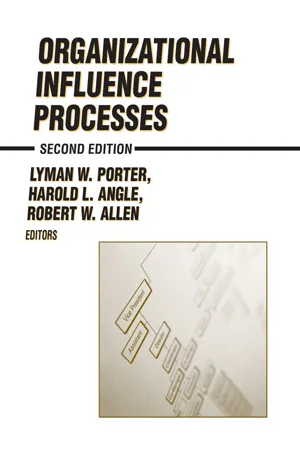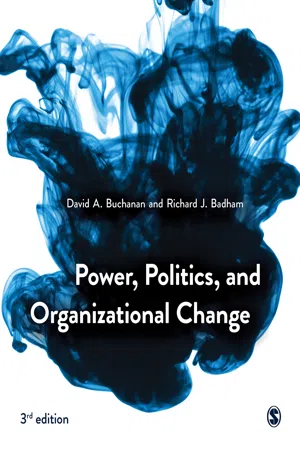Business
Power Tactics
Power tactics refer to the strategies used by individuals or groups to gain and maintain power in a business setting. These tactics can include persuasion, manipulation, coercion, and negotiation, among others. Understanding power tactics can help individuals navigate complex power dynamics and achieve their goals in the workplace.
Written by Perlego with AI-assistance
Related key terms
4 Key excerpts on "Power Tactics"
- eBook - ePub
- James T. Tedeschi(Author)
- 2017(Publication Date)
- Routledge(Publisher)
Employing such tactics, an individual may attain valued outcomes from another person or remain independent of the other’s demands. This chapter’s fundamental concern lies with these strategic behaviors, which are termed Power Tactics, and with the determinants of their use and effectiveness. This chapter, therefore, has two objectives: to present an exchange model of Power Tactics and to review recent experimental research treating issues raised by the model. To begin the chapter, we explicate the model of power relationships and demonstrate how it systematizes a perplexing array of Power Tactics discussed by various writers. A subsequent discussion of research questions applicable to the model substantiates its merit as a conceptual framework. Next, we review some of the recent experimental studies bearing on these research questions, thereby indicating which questions have been (partially) answered and which have not. Finally, this chapter explores some relations between Power Tactics and the emergence of norms and status in groups. Our goal is the understanding of Power Tactics in social interaction. Our route toward that goal takes us through a discussion of social interaction as an exchange process. Social Relationships as Exchanges People in interaction often control the flow of valued outcomes to one another. These valued outcomes may be tangible, as in an exchange of money for food or clothing, or they may be intangible, as in the requital of conformity to group expectations for expressions of approval from other group members. Social exchange theory, as explicated by Homans (1961) and Gergen (1969), specifies conditions under which persons will reciprocate valued outcomes. In general terms, the value of a behavioral outcome to others and the scarcity of the outcome are the primary determinants of its exchangeability - eBook - ePub
Principles of Organizational Behavior
The Handbook of Evidence-Based Management
- Craig L. Pearce, Edwin A. Locke, Craig L. Pearce, Edwin A. Locke(Authors)
- 2023(Publication Date)
- Wiley(Publisher)
15 Effective Use of Power and Influence Tactics in Organizations GARY YUKL State University of New York at Albany INTRODUCTION The concept of “power” has been very useful for understanding how people in organizations are able to influence each other (Mintzberg, 1983 ; Pfeffer, 1981, 1992 ; Yukl, 2013). Power is usually defined as potential influence over people and events. In this chapter, the focus is on the potential influence of one person (the “agent”) on the work-related attitudes and behavior of one or more members of an organization (“target persons”). There are different types of power, and an agent usually has more of some types than of other types. This chapter will describe each type of power and how it is relevant for effective job performance in organizations. Proactive influence tactics are specific behaviors used in organizations to influence a target person to carry out a work-related request or to support a proposed change. This chapter describes 11 different types of proactive influence tactics that may be used by a leader or other member of an organization. The relevance, feasibility, and effectiveness of each type of proactive tactic depend in part on several aspects of the situation, including the influence objective and the agent's power over the target person. SOURCES OF INDIVIDUAL POWER Social scientists usually differentiate between position power and personal power (French and Raven, 1959 ; Yukl and Falbe, 1991). Position power is the potential influence derived from the agent's position and role in the organization, and it is determined by organizational policies, rules, and regulations, formal reward systems, legal constraints, and labor union contracts. The specific types of position power include legitimate authority, reward power, coercive power, and information power. Personal power is potential influence derived from agent characteristics and some aspects of the relationship between the agent and a target person - eBook - ePub
- Robert W. Allen, Lyman W. Porter, H.L. Angle(Authors)
- 2016(Publication Date)
- Routledge(Publisher)
This reading makes salient the idea that power acquisition often involves the possession of “real” resources and means, but it can involve more symbolic or impressionistic “resources” as well. To the extent that a subunit is deficient in its control over more tangible means, it may well be faced with the necessity to attempt to make up for such deficits through impression-management and similar tactics. (It should be noted, that the data presented in this reading are not very supportive of the efficacy of symbolic action.)One additional aspect of the Galang and Ferris reading bears mention. The authors make a cogent argument that gaining an understanding of the dynamics of power requires us to find some consensual definition of the power construct. Without that, the task of building a coherent and informative stream of research on power becomes the proverbial exercise in futility. As the authors point out, the recent state of scholarship on power has simply not yielded a consensus in this respect. Further, the authors’ own research data, in which they analyze the antecedents of five different components of power, lends further emphasis to the point that what we know about power—and therefore organizational influence processes—depends on how we conceive of power in the first place.The final offering in Part 1 is “Consequences of Influence Tactics Used with Subordinates, Peers, and the Boss,” by Gary Yukl and J. Bruce Tracey. The reading extends our consideration of the gamut of influence tactics to a specific focus on the effectiveness of the various tactics. The article presents a research study in which managers’ use of nine different influence tactics were related to the influence targets’ task commitment, as well as to measures of managerial effectiveness. These nine tactics (rational persuasion, inspirational appeal, consultation, ingratiation, exchange, personal appeal, coalition, legitimating, and pressure) - eBook - ePub
- David Buchanan, Richard Badham(Authors)
- 2020(Publication Date)
- SAGE Publications Ltd(Publisher)
powerlessness corrupts. Why? When leaders lack power, they have to become shouty and aggressive in order get others to do what they want them to do. The American gangster Al Capone once famously said, ‘You can go a long way with a smile. You can go a lot farther with a smile and a gun.’ A leader who has power can get things done more quickly and easily than one who does not. Leaders who do not have power, and who are either unwilling or unable to ‘play the politics’, often struggle to achieve their objectives.An inescapable feature of organizational life, the exercise of power can be damaging, but as we shall demonstrate, power and politics can also be used in constructive ways, to solve problems, generate consensus, resolve conflict – and above all to drive change. Change in an organization can intensify the power plays and political behaviour, because change creates winners and losers – or individuals and groups who believe that their positions will either be strengthened or weakened. Power is often a motive for change, reinforcing someone’s power base, and limiting others’ (Roy Suddaby and William Foster, 2017).We think of organizations as rational and orderly, with decisions based on evidence and reason, focusing on efficiency and effectiveness. But organizations are also political systems, and decisions are shaped by influence tactics that are designed to promote the interests of individuals or groups. As organizations become less hierarchical, and come to rely more on networks and teams, the use of power and influence becomes more important than formal authority. Power and politics are linked. Power can be seen as the ability to get other people to do what you want them to do, and it is often necessary to use political tactics to achieve those ends. Political behaviour can thus be seen as ‘power in action’.An organization’s members do not always share the same values and goals. Disagreements over the definitions of problems, and how best to solve them, are normal. These disputes are often healthy, by exposing different perspectives and issues, and by reducing support for lousy ideas. What happens, however, when the sharing of views fails to produce consensus? Sometimes, those with the best ideas win. Often, the winners are those who are more powerful, and who are able to exercise influence ‘behind the scenes’, by ‘playing politics’. Good ideas do not always sell themselves, and rational arguments may not be effective on their own. As the American diplomat Henry Kissinger once said:
Learn about this page
Index pages curate the most relevant extracts from our library of academic textbooks. They’ve been created using an in-house natural language model (NLM), each adding context and meaning to key research topics.



